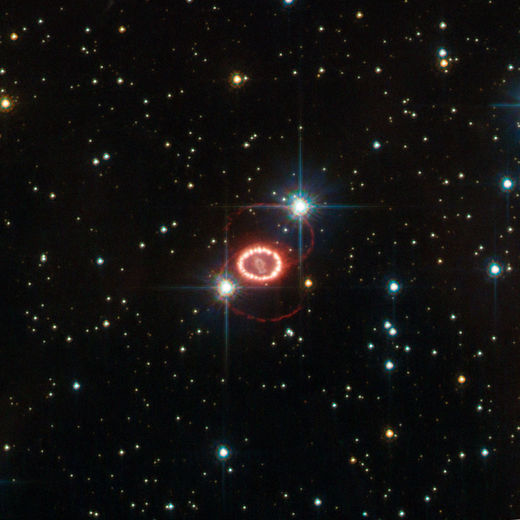
Experimental observations from Supernova 1987a showed that the first neutrinos arrived approximately 7.7 h before the first photons.
The theory of general relativity suggests that light travels at a constant speed of 299,792,458 meters per second in a vacuum. It's the c in Einstein's famous equation after all, and virtually everything measured in the cosmos is based on it - in short, it's pretty important. But, what if it's wrong?
Comment: In fact, general relativity predicts that the velocity of light would be reduced by a gravitational potential, the author proposes a correction by using a first approximation effect of a gravitational field in the framework of the quantum electrodynamics theory. Light velocity is constant in the theory of special relativity where no interaction fields are involved.
Franson's arguments are based on observations made of the supernova SN 1987A - it exploded in February 1987. Measurements here on Earth picked up the arrival of both photons and neutrinos from the blast but there was a problem - the arrival of the photons was later than expected, by 4.7 hours. Scientists at the time attributed it to a likelihood that the photons were actually from another source. But what if that wasn't what it was, Franson wonders, what if light slows down as it travels due to a property of photons known as vacuum polarization - where a photon splits into a positron and an electron, for a very short time before recombining back into a photon. That should create a gravitational differential, he notes, between the pair of particles, which, he theorizes, would have a tiny energy impact when they recombine - enough to cause a slight bit of a slowdown during travel. If such splitting and rejoining occurred many times with many photons on a journey of 168,000 light years, the distance between us and SN 1987A, it could easily add up to the 4.7 hour delay, he suggests.
Comment: Maybe there is no need for a star trek explanation. Since interstellar space is not totally empty, it is only natural to attribute a refraction index to certain zones in space (like on earth, light propagates more slowly in water than in the air for instance). That may explain perhaps the so-called "gravitational lenses" and make some cosmologists angry.
If Franson's ideas turn out to be correct, virtually every measurement taken and used as a basis for cosmological theory, will be wrong. Light from the sun for example, would take longer to reach us than thought, and light coming from much more distant objects, such as from the Messier 81 galaxy, a distance of 12 million light years, would arrive noticeably later than has been calculated - about two weeks later. The implications are staggering - distances for celestial bodies would have to be recalculated and theories that were created to describe what has been observed would be thrown out. In some cases, astrophysicists would have to start all over from scratch.
More information: Apparent correction to the speed of light in a gravitational potential, J. D. Franson 2014, New J. Phys. 16, 065008



Comment: Space is not empty, and while the author tries to introduce a gravitational field to quantum electrodynamics equations, it could be argued that the presence of charged matter along with electromagnetic fields across large distances in space may indeed be more straightforward source of light velocity slowing and spectral shifts (notably red shifts). Only time will tell if theoretical physicists will pursue the matter further.